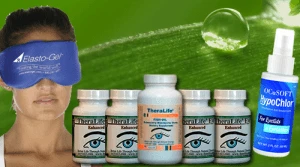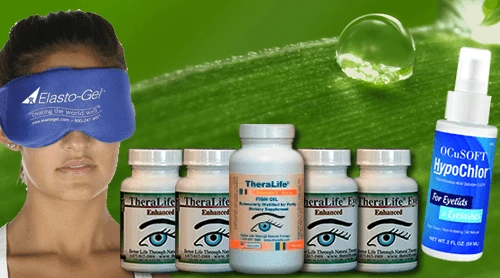Theralife.com offers a range of products that benefit customers dealing with blepharitis and other eye conditions. These products are designed to soothe symptoms by leveraging natural ingredients and supplements. For instance, Theralife products include omega-3 rich formulas and antioxidants that help modulate inflammation and support tear film health. Additionally, they offer probiotics aimed at balancing gut microbiota, which in turn can influence ocular surface inflammation, providing relief for blepharitis symptoms.
Theralife.com also emphasizes the importance of a comprehensive approach to eye health, which includes a diet rich in essential vitamins from leafy greens and polyphenols from colorful berries. These components contribute to ocular integrity and offer protective effects against inflammation. By integrating these dietary elements with Theralife’s specialized products, customers can explore effective ways to manage and control blepharitis, enhancing overall eye health and comfort.
Best Blepharitis Treatment From TheraLife- When Drops Don’t Work.
Key Takeaways
- Leafy green vegetables supply vitamins and antioxidants that support ocular health and may reduce blepharitis flare-ups.
- Nuts and seeds offer essential fatty acids and vitamin E, helping modulate eyelid inflammation.
- Colorful berries are high in antioxidants and flavonoids that help combat eye inflammation and oxidative stress.
- Probiotic foods like yogurt and fermented vegetables support gut health, which can influence ocular surface inflammation.
- Omega-3 rich fish provide beneficial fatty acids, but evidence for direct relief of blepharitis symptoms is limited.
Omega-3 Rich Fish
Despite common recommendations, eating omega-3 rich fish such as salmon, sardines, or mackerel hasn’t shown consistent evidence for reducing blepharitis symptoms. Clinical studies remain inconclusive, indicating that dietary omega-3 intake doesn’t reliably improve eyelid inflammation or meibomian gland dysfunction in affected individuals. If you still choose to include these fish in your diet, prioritize sustainable fishing sources to support ecological balance and avoid overfishing. Proper fish preparation—such as grilling or baking instead of deep-frying—preserves nutrient integrity and avoids introducing excessive saturated fats, which could have negative health impacts. While omega-3 fatty acids offer benefits for cardiovascular health, the scientific data specific to blepharitis relief is insufficient. Symptoms of Dry Eye, such as burning, itching, and heavy eyes, can sometimes overlap with blepharitis, making it essential to seek professional advice. You should focus on proven management strategies for blepharitis, consulting your ophthalmologist for tailored advice.
Leafy Green Vegetables
Many leafy green vegetables, including spinach, kale, and Swiss chard, provide an excellent source of vitamins A, C, and K, as well as lutein and zeaxanthin—nutrients essential for maintaining overall ocular health.
When you incorporate leafy greens into your diet, you help support your eyes’ natural defenses. Vitamin A maintains the integrity of the ocular surface and supports tear film production, which may relieve blepharitis symptoms.
Lutein and zeaxanthin, powerful carotenoids, are associated with reduced oxidative stress in eye tissues, further protecting against inflammation. Evidence suggests that vitamin C also enhances collagen synthesis in conjunctival tissues, promoting better eye health.
Regularly consuming leafy greens provides key micronutrients that target ocular inflammation and might reduce blepharitis flare-ups. Aim to include these vegetables in your daily meals for ideal eye health.
The AIP diet, which focuses on healing the immune system by eliminating trigger foods, may also complement the benefits of consuming nutrient-rich leafy greens in managing ocular inflammation and overall eye health.
Nuts and Seeds
Almonds, walnuts, flaxseeds, and chia seeds deliver essential fatty acids—particularly omega-3s—that play a significant role in modulating inflammation associated with blepharitis.
By integrating these nut benefits and various seed varieties into your diet, you can enhance the lipid profile of your tear film and support ocular surface health. Omega-3s are scientifically proven to reduce meibomian gland dysfunction, a core driver of blepharitis symptoms.
Additionally, vitamin E and zinc—abundant in nuts and seeds—possess antioxidant properties, aiding in cellular repair and mitigating oxidative stress on eyelid margins.
Consuming a mix of nuts and seeds increases nutrient diversity, so you’ll gain both anti-inflammatory effects and crucial micronutrients.
Opt for unsalted, raw forms to avoid excess sodium, which could exacerbate inflammation. Adding warm compresses to your daily routine can further alleviate blepharitis symptoms by enhancing blood circulation and reducing inflammation.
Colorful Berries
In addition to nutrient-rich nuts and seeds, incorporating colorful berries into your diet can further support ocular health in the context of blepharitis. Berries are packed with antioxidants, particularly vitamin C, vitamin E, and flavonoids, which help reduce oxidative stress in ocular tissues.
These antioxidant benefits are vital for combatting chronic inflammation associated with blepharitis and maintaining the function of the Meibomian glands. Recent studies show that regular intake of various berry varieties can help lower the risk of dry eye syndromes and fortify the eye’s natural defenses.
To maximize benefits, include a diverse selection of berries in your diet:
- Blueberries
- Strawberries
- Blackberries
- Raspberries
- Acai berries
You’ll find that the polyphenol content in colorful berries provides extensive ocular support. Moreover, hot compresses help unclog meibomian glands for normal function, which is crucial in managing blepharitis symptoms effectively.
Probiotic Foods
Gut health profoundly influences ocular surface inflammation, making probiotic foods an important dietary consideration for those managing blepharitis. By incorporating probiotic yogurt and fermented vegetables into your diet, you can help modulate the gut microbiota, which plays a role in systemic and ocular inflammation.
Evidence suggests that an imbalance in gut flora may exacerbate inflammatory conditions, including eyelid margin disorders like blepharitis. Regular consumption of probiotic yogurt provides beneficial bacteria, such as Lactobacillus and Bifidobacterium species, supporting gut barrier function and immune modulation.
Similarly, fermented vegetables—like sauerkraut and kimchi—offer diverse strains of probiotics. Including these foods can reduce pro-inflammatory cytokines, potentially decreasing eyelid irritation and meibomian gland dysfunction.
Maintaining eyelid cleanliness is essential for managing symptoms of blepharitis, as poor eyelid hygiene can exacerbate the condition.
Prioritize food-based sources for maximum efficacy and tolerance.
Best Blepharitis Treatment From TheraLife- When Drops Don’t Work.
Frequently Asked Questions
Are There Any Foods That Can Worsen Blepharitis Symptoms?
Yes, certain trigger foods can worsen blepharitis symptoms by promoting inflammation.
You should avoid inflammatory diets high in refined sugars, processed foods, and trans fats, as they can aggravate eyelid irritation.
Some individuals find that dairy or gluten-containing foods trigger flare-ups.
It’s important to monitor your response to different foods and consider dietary modifications based on evidence-based guidelines to help manage chronic eyelid inflammation and blepharitis symptoms effectively.
Can Hydration or Specific Drinks Help Manage Blepharitis?
You should prioritize hydration benefits, as proper fluid intake helps maintain tear film stability and reduces eyelid inflammation.
Drink recommendations include water, herbal teas, and electrolyte-rich fluids, which support ideal ocular surface health.
Avoid caffeinated and sugary drinks, since they can exacerbate dehydration.
Evidence suggests consistent hydration aids in meibomian gland function, lessening blepharitis symptoms.
Always consult an ophthalmologist for tailored medical recommendations regarding your ocular surface and general eye health.
How Quickly Can Diet Changes Affect Blepharitis Flare-Ups?
When it comes to dietary impact on blepharitis, don’t expect changes overnight—healing takes time.
You might notice mild symptom management within a few weeks, especially when you consistently incorporate anti-inflammatory nutrients or omega-3 fatty acids.
However, clinical evidence suggests effects vary based on individual health factors and disease severity.
For some, dietary modifications can contribute to long-term flare-up reduction rather than immediate relief, so persistence is key for meaningful improvement.
Are There Any Vitamins Specifically Recommended for Blepharitis?
You’ll find that certain vitamins, such as vitamin A, vitamin D, and omega-3 fatty acids, are specifically recommended for blepharitis due to their roles in ocular surface health and inflammation control.
Ensuring adequate vitamin sources—like fatty fish for omega-3s or dairy for vitamin D—can optimize nutrient absorption.
Evidence suggests these nutrients support meibomian gland function and tear film stability, contributing to symptomatic relief and improved ocular surface homeostasis.
Can Food Allergies Trigger or Worsen Blepharitis Symptoms?
Think of your immune system as a smoke detector—when food intolerance or allergy symptoms set it off, inflammation can spread like smoke, potentially worsening blepharitis.
While evidence is limited, studies suggest that allergic reactions may contribute to eyelid irritation by triggering immune-mediated responses.
If you notice flare-ups after certain foods, consult an allergist. They can help you pinpoint triggers and manage underlying food sensitivities that could aggravate blepharitis symptoms.
Best Blepharitis Treatment From TheraLife- When Drops Don’t Work.
Conclusion
Imagine your eyes refreshed, lids soothed, and vision clear with TheraLife’s targeted solutions for blepharitis. Their comprehensive range of products, including TheraLife Eye Enhanced, is designed to alleviate symptoms by addressing inflammation, enhancing tear film stability, and restoring ocular surface health. TheraLife’s evidence-based formulas incorporate natural ingredients and are backed by scientific research, offering a holistic approach to eye health. By integrating TheraLife into your routine, you can support optimal eyelid function and experience a clearer, brighter outlook. Let TheraLife’s innovative products help you manage blepharitis symptoms effectively, empowering you to enjoy an improved quality of life.
References
- 1.
- Putnam CM. Diagnosis and management of blepharitis: an optometrist’s perspective. Clin Optom (Auckl). 2016;8:71-78. [PMC free article] [PubMed]
- 2.
- Huggins AB, Carrasco JR, Eagle RC. MEN 2B masquerading as chronic blepharitis and euryblepharon. Orbit. 2019 Dec;38(6):514-518. [PubMed]
- 3.
- Dietrich-Ntoukas T. [Chronic Blepharitis]. Klin Monbl Augenheilkd. 2022 Nov;239(11):1381-1393. [PubMed]
- 4.
- Rodriguez-Garcia A, Loya-Garcia D, Hernandez-Quintela E, Navas A. Risk factors for ocular surface damage in Mexican patients with dry eye disease: a population-based study. Clin Ophthalmol. 2019;13:53-62. [PMC free article] [PubMed]
- 5.
- Choi FD, Juhasz MLW, Atanaskova Mesinkovska N. Topical ketoconazole: a systematic review of current dermatological applications and future developments. J Dermatolog Treat. 2019 Dec;30(8):760-771. [PubMed]
- 6.
- Tavassoli S, Wong N, Chan E. Ocular manifestations of rosacea: A clinical review. Clin Exp Ophthalmol. 2021 Mar;49(2):104-117. [PubMed]
- 7.
- Lin A, Ahmad S, Amescua G, Cheung AY, Choi DS, Jhanji V, Mian SI, Rhee MK, Viriya ET, Mah FS, Varu DM., American Academy of Ophthalmology Preferred Practice Pattern Cornea/External Disease Panel. Blepharitis Preferred Practice Pattern®. Ophthalmology. 2024 Apr;131(4):P50-P86. [PubMed]
- 8.
- Ozkan J, Willcox MD. The Ocular Microbiome: Molecular Characterisation of a Unique and Low Microbial Environment. Curr Eye Res. 2019 Jul;44(7):685-694. [PubMed]
- 9.
- Khoo P, Ooi KG, Watson S. Effectiveness of pharmaceutical interventions for meibomian gland dysfunction: An evidence-based review of clinical trials. Clin Exp Ophthalmol. 2019 Jul;47(5):658-668. [PubMed]
- 10.
- Soh Qin R, Tong Hak Tien L. Healthcare delivery in meibomian gland dysfunction and blepharitis. Ocul Surf. 2019 Apr;17(2):176-178. [PubMed]
- 11.
- Fromstein SR, Harthan JS, Patel J, Opitz DL. Demodex blepharitis: clinical perspectives. Clin Optom (Auckl). 2018;10:57-63. [PMC free article] [PubMed]
- 12.
- Romanowski JE, Nayyar SV, Romanowski EG, Jhanji V, Shanks RMQ, Kowalski RP. Speciation and Antibiotic Susceptibilities of Coagulase Negative Staphylococci Isolated from Ocular Infections. Antibiotics (Basel). 2021 Jun 16;10(6) [PMC free article] [PubMed]
- 13.
- Wolf R, Orion E, Tüzün Y. Periorbital (eyelid) dermatides. Clin Dermatol. 2014 Jan-Feb;32(1):131-40. [PubMed]
- 14.
- Chioveanu FG, Niculet E, Torlac C, Busila C, Tatu AL. Beyond the Surface: Understanding Demodex and Its Link to Blepharitis and Facial Dermatoses. Clin Ophthalmol. 2024;18:1801-1810. [PMC free article] [PubMed]
- 15.
- Sandford EC, Muntz A, Craig JP. Therapeutic potential of castor oil in managing blepharitis, meibomian gland dysfunction and dry eye. Clin Exp Optom. 2021 Apr;104(3):315-322. [PubMed]
- 16.
- Rhee MK, Yeu E, Barnett M, Rapuano CJ, Dhaliwal DK, Nichols KK, Karpecki P, Mah FS, Chan A, Mun J, Gaddie IB. Demodex Blepharitis: A Comprehensive Review of the Disease, Current Management, and Emerging Therapies. Eye Contact Lens. 2023 Aug 01;49(8):311-318. [PMC free article] [PubMed]
- 17.
- Lemp MA, Nichols KK. Blepharitis in the United States 2009: a survey-based perspective on prevalence and treatment. Ocul Surf. 2009 Apr;7(2 Suppl):S1-S14. [PubMed]
- 18.
- Schaumberg DA, Nichols JJ, Papas EB, Tong L, Uchino M, Nichols KK. The international workshop on meibomian gland dysfunction: report of the subcommittee on the epidemiology of, and associated risk factors for, MGD. Invest Ophthalmol Vis Sci. 2011 Mar;52(4):1994-2005. [PMC free article] [PubMed]
- 19.
- Viso E, Rodríguez-Ares MT, Abelenda D, Oubiña B, Gude F. Prevalence of asymptomatic and symptomatic meibomian gland dysfunction in the general population of Spain. Invest Ophthalmol Vis Sci. 2012 May 04;53(6):2601-6. [PubMed]
- 20.
- Rim TH, Kang MJ, Choi M, Seo KY, Kim SS. Ten-year incidence and prevalence of clinically diagnosed blepharitis in South Korea: a nationwide population-based cohort study. Clin Exp Ophthalmol. 2017 Jul;45(5):448-454. [PubMed]





